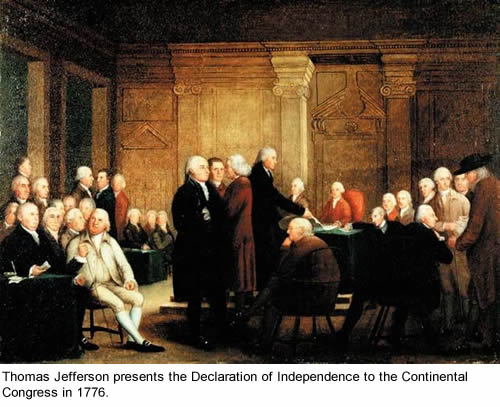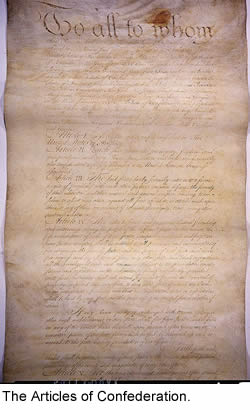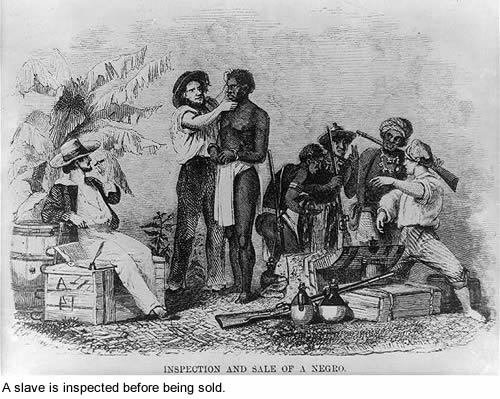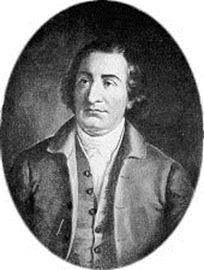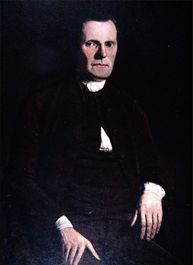Learn
To access the materials on Discovery Education website, you will need to log in. View the login instructions.
- Articles of Confederation
- Weaknesses
- Shays' Rebellion
- Constitutional Convention
- Conflict
- Compromise
- Key Players
First Attempt at Governing
After America declared independence from Great Britain in 1776, the Second Continental Congress urged the states to write new constitutions. Also, Congress formed a committee to prepare a national constitution. The committee's goal was to create a central government that would unify the thirteen individual states and provide for their common defense, but would not lead to tyranny like they had experienced under British rule.
Watch The Thirteen Colonies: From the Articles of Confederation to a Centralized Government (4:24) to learn more about our first attempt at governing the new nation.
Articles of Confederation
Within a year, the committee completed the Articles of Confederation, the first written plan of government for the United States. By 1779, twelve states had ratified the Articles. Maryland was the last state to ratify the Articles in 1781. Despite many problems under the Articles, the states fought and won independence from Great Britain, negotiated a peace treaty with European powers, and laid the framework for the present-day government. The Articles of Confederation was written to bind together thirteen "free and independent states" that wanted to maintain their sovereignty.
Watch The Articles of Confederation: 1781-1788 (1:26) to learn about our first plan of government.
Image credit: Edward Savage and/or Robert Edge Pine. Congress Voting Independence. c. 1784-1801. Wikimedia Commons.
Weaknesses of the Articles
The Articles of Confederation purposefully created a weak central government. The Founding Fathers feared that a strong central government would lead to tyranny like they had experienced under British rule, so they created a weak central government with a unicameral congress with very limited powers. Furthermore, the Articles did not provide for an executive nor judicial branch, which means there was no president or federal court system.
Under the Articles of Confederation, Congress lacked the following powers:- to enforce its own laws (no federal courts meant no way to enforce the laws);
- to collect taxes (left only the power to print Continental dollars, which had no value);
- to control trade among states (trade disputes among the states was a major concern);
- to raise troops.
The government established by the Articles kept every state as independent as possible.
Read "Identifying Defects in the Confederation" to learn more about the weaknesses of the Articles of Confederation.
Growing Pains
The new government had several flaws, but one of the toughest challenges that the Congress faced was finances. The United States accrued a large war debt to France and private individuals that it could not repay. States continued to print currency, which led to further inflation. Also, trade restrictions put in place by England, France, and Spain were stifling the sale of American goods and Congress continued to struggle with national debt.
Lacking the power to tax its citizens, the new government was hard-pressed to find a financial solution. It found its answer in land sales of the Northwest Territory. In 1785 and 1787, Congress divided up the territory for sale and set provisions for statehood that would further expand our nation's borders.
Northwest Ordinance of 1787
It has been argued that the Northwest Ordinance of 1787 was the most important legislation passed by the Continental Congress (besides the Declaration of Independence) under the Articles of Confederation. The Northwest Ordinance of 1787 created the first organized territory of the United States, the Northwest Territory. It established a plan for settling new territory and admitting new states. Nevertheless, the economy under the Articles continued to struggle.
Image credit: Western Land Claims by the Original 13 States. IRC, 2005. Discovery Education.
Shays' Rebellion
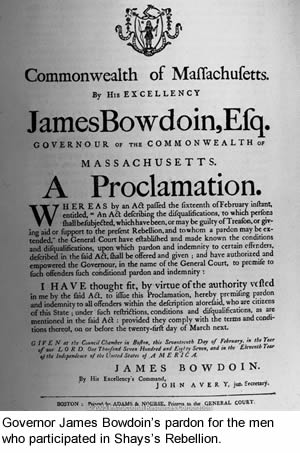
The postwar economy in America was depressed. States either chose to print currency or tax their citizens to pay off debt. Massachusetts, like many other states, levied taxes. As a result, the state's farmers, many of whom were veterans, were losing their farms because they could not pay the taxes.
In 1786, the overbearing taxes led to an uprising by Massachusetts farmers known as Shays' Rebellion. Daniel Shays, a farmer and former captain in the Continental Army, led rebels to close the courts by force and free prisoners from jail who had unpaid taxes and debts. Shays' Rebellion led many central figures to question the need for a stronger central government.
Read "Shays' Rebellion" to learn more about the crisis caused by a weak central government.
Watch The Problem of Debt and Shays' Rebellion (2:59) to learn more about some of the problems the United States faced under the Articles of Confederation.
Revising the Articles of Confederation
America's economic difficulties during the 1780s ultimately led to the call for a stronger central government. Even before the dissention of Shays' Rebellion occurred, five states gathered together at the Annapolis Convention to settle the dispute between Maryland and Virginia over the Potomac River. It was clear to the delegates at the Annapolis Convention that the obvious economic and trade problems created by a weak central government, limited by the inadequacies of the Articles of Confederation, must be addressed at a general meeting of all states.
Watch Drafting the Constitution of the United States (2:02) to learn more about the need to revise the Articles of Confederation.
Image credit: Bowdoin Pardons Shays's Rebellion Participants IRC, 2005. Image. Discovery Education.
The Constitutional Convention
In May 1787, fifty-five delegates from every state except Rhode Island assembled in Independence Hall in Philadelphia, Pennsylvania for a meeting. The purpose of the meeting was to revise the Articles of Confederation, but the delegates decided to write an entirely new national constitution. This historic meeting is known today as the Constitutional Convention. The delegates quickly elected George Washington as presiding officer of the convention.
Watch The Constitutional Convention: May-September, 1787 (1:01) to learn more.
Key Players at the Convention
This group of men, which included Benjamin Franklin, Alexander Hamilton, George Washington, and James Madison, were the most outstanding leaders of their time. Most of the delegates were wealthy, well-educated, and prominent in state and/or national affairs. The average age of the delegates was about 42 years. Today, we refer to them as the nation's "founding fathers."
The Constitutional Convention took place at the Pennsylvania State House during a very hot summer. Since the delegates were sworn to secrecy, the windows were kept shut to prevent people on the street from hearing the discussions. Fortunately, Virginian James Madison attended every meeting during the convention and kept excellent notes on the proceedings. His notes are the best record of the convention. Madison is known today as the "father of the Constitution."

Read "A Cast of National Superstars" to learn more about the key players at the Convention.
Image credit: Washington Presiding in the Convention 1787. Corbis, 2006. Image. Discovery Education.
Conflict at the Convention
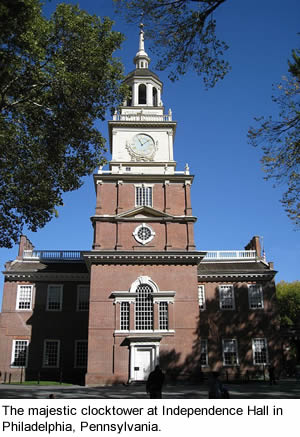
The thirteen new states were vastly different in their size, economies, and ideas about republicanism. The latter had been evident in their state constitutions. Their task was to form a central government that would serve the best interests of the entire nation. Virginia and New Jersey both introduced plans of government that would suit the needs of large and small states respectively, but neither were happy with the other's plans.
Watch Debates in the Constitutional Convention (4:00) to learn more about the debates.
The Virginia Plan
Virginians Edmund Randolph and James Madison proposed a plan with three branches of government that would do away with the Articles of Confederation, which only had a legislative branch. Their plan was clearly more than a "revision" of the Articles. The following are the key features of the Virginia Plan:
- The Legislative Branch would be bicameral with representation based on population, which would give Congress more power over the states.
- An executive branch and a judicial branch would both be selected by the legislature.
In other words the larger states, like Virginia, would benefit from the Virginia Plan by having more representatives in Congress to equal their larger state populations.
The New Jersey Plan
Smaller states, fearful of their fate if the Virginia plan was approved, devised their own plan. New Jersey delegate William Paterson proposed the New Jersey Plan to give small states the same power as large states in Congress. The following are the key proposals in the New Jersey Plan:
- A unicameral legislature where each state would have one vote. Congress would have the power to tax and regulate trade.
- An executive branch.
- A judicial branch.
The heated debate between delegates from large and small states over representation in Congress continued over the summer of 1787.
Watch Equal Representation in Congress (3:29) to learn more about the debate between large and small states.
Image credit: The clocktower at Independence Hall. Philadelphia, PA. Theberge, 2010. Image. Wikimedia Commons.
The Great Compromise
Perhaps the greatest debate between the delegates to the Constitutional Convention centered on how many representatives each state should have in the new Congress. Two plans were proposed: the Virginia Plan and the New Jersey Plan, but the delegates could not agree on which plan to adopt. On July 2, 1787, a vote on the issue was split. The situation seemed hopelessly deadlocked.
Roger Sherman, a delegate from Connecticut, proposed the Great Compromise which resolved the issue over representation by creating a legislative branch with two houses, as called for by the Virginia Plan. In one house, the Senate, all states would be represented equally, regardless of size, as called for by the New Jersey plan. In the second house, the House of Representatives, representation would be based on state population. The Great Compromise was approved on July 16, 1787.
Read "Constitution Through Compromise" to learn more about the Great Compromise.
The Three-Fifths Compromise
The issue of slavery was another issue that divided the states at the convention. The southern states wanted slaves to be counted as part of their population, which would increase their representation in the House. Northern states felt slaves should not be counted because they were treated as property in the south.
The Three-Fifths Compromise was reached and allowed three-fifths of a state's slave population to be counted in determining representation in Congress.
Watch The Three-Fifths Compromise (:49) to learn more about the debate.
Image credit: The inspection and sale of a Negro. Mayer, circa 1854. Image. Wikimedia Commons.
Review of Key Players at the Convention
|
Edmund Randolph favored large states and based repesentation on population. |
William Paterson proposed the New Jersey Plan which favored small states and was based on equal representation in a unicameral legislature. |
Roger Sherman proposed the Great Compromise which called for a bicameral legislature. Representation in the Senate would be equal. Representation in the House of Representatives would be based on population. |
Watch Great Men of the Constitutional Convention (3:47) to learn more.
